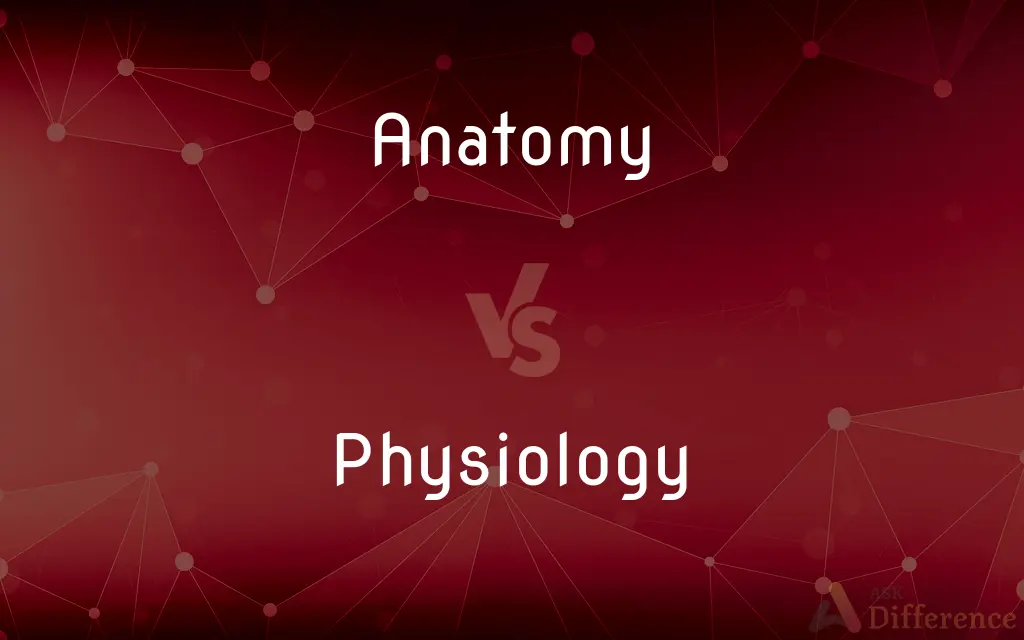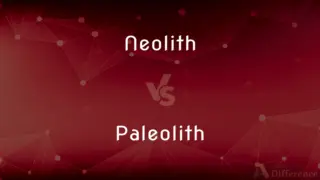Anatomy vs. Physiology — What's the Difference?
By Fiza Rafique & Urooj Arif — Updated on March 16, 2024
Anatomy studies the structure of body parts, their organization, and relationship to each other, while physiology focuses on how those parts function and interact within the body.

Difference Between Anatomy and Physiology
Table of Contents
ADVERTISEMENT
Key Differences
Anatomy is the branch of biology concerned with the study of the structure of organisms and their parts. It delves into the physical structures, or morphologies, of body parts, including their shapes, sizes, and compositions. Whereas physiology examines the functions and processes of the body's components, exploring how bodily parts operate and work together to sustain life.
While anatomy provides a detailed mapping and naming of various parts of an organism, such as organs, muscles, and bones, physiology brings insight into the biochemical, physical, and mechanical functions of these parts. For instance, anatomy will detail the structure of the heart, whereas physiology explains how the heart pumps blood throughout the body.
Anatomy is often divided into subcategories such as gross (macroscopic) anatomy, which includes structures visible to the naked eye, and microscopic anatomy, which involves the use of microscopes to see finer details not observable by the naked eye. On the other hand, physiology covers broad areas, including cellular physiology, which focuses on cell function, and systems physiology, which looks at the function of specific organ systems.
Studying anatomy involves techniques and approaches such as dissection and imaging technology to visualize the interior of the body, providing a static picture of bodily structures. Physiology, however, employs experiments, measurements, and simulations to understand dynamic processes, such as nerve impulses or blood circulation, highlighting the functional aspects of the body.
Both anatomy and physiology are foundational to the medical and biological sciences, offering complementary perspectives on the human body. Understanding anatomy is crucial for identifying parts of the body and their relationships, while knowledge of physiology is essential for comprehending how those parts function and contribute to overall health and disease states.
ADVERTISEMENT
Comparison Chart
Focus
Structure of body parts
Function of body parts
Subcategories
Gross anatomy, microscopic anatomy
Cellular physiology, systems physiology
Methods
Dissection, imaging technology
Experiments, simulations
Objective
Identify and describe body parts and their relations
Understand how body parts operate and interact
Relevance
Essential for medical diagnosis, surgery
Crucial for understanding health, disease mechanisms
Compare with Definitions
Anatomy
The scientific study of the physical structure of organisms.
Anatomy classes often begin with the dissection of specimens to observe internal structures.
Physiology
The science of how body parts function and work together in living organisms.
Physiology studies can explain how muscle contraction occurs at a cellular level.
Anatomy
Utilizes dissection and advanced imaging techniques to explore bodily structures.
MRI scans are used in anatomy to visualize organs in detail without invasive procedures.
Physiology
On biological and chemical processes that drive bodily functions.
Cardiac physiology includes understanding how the heart's electrical system regulates heartbeat.
Anatomy
Includes areas like histology (study of tissues) and embryology (study of developmental structures).
Histology examines the microscopic structure of tissues, providing insights into their functions.
Physiology
Essential for developing treatments and understanding diseases.
Understanding the physiology of diabetes is crucial for developing effective treatments.
Anatomy
On the physical and spatial characteristics of organs and tissues.
Studying the anatomy of the brain involves learning about its various regions and neuronal pathways.
Physiology
Broadly categorized into areas such as neurophysiology and cardiovascular physiology.
Neurophysiology explores how the nervous system processes signals.
Anatomy
Critical in fields such as surgery, where a deep understanding of bodily structures is essential.
Surgeons rely on their anatomical knowledge to navigate complex operations safely.
Physiology
Employs experimental techniques to study life processes, from molecular to systemic levels.
Physiologists might use electrophysiology to study how nerves conduct electrical impulses.
Anatomy
Anatomy (Greek anatomē, 'dissection') is the branch of biology concerned with the study of the structure of organisms and their parts. Anatomy is a branch of natural science which deals with the structural organization of living things.
Physiology
Physiology (; from Ancient Greek φύσις (physis) 'nature, origin', and -λογία (-logia) 'study of') is the scientific study of functions and mechanisms in a living system. As a sub-discipline of biology, physiology focuses on how organisms, organ systems, individual organs, cells, and biomolecules carry out the chemical and physical functions in a living system.
Anatomy
The bodily structure of a plant or an animal or of any of its parts.
Physiology
The biological study of the functions of living organisms and their parts.
Anatomy
The science of the shape and structure of organisms and their parts.
Physiology
All the functions of a living organism or any of its parts.
Anatomy
A treatise on anatomic science.
Physiology
A branch of biology that deals with the functions and activities of life or of living matter (as organs, tissues, or cells) and of the physical and chemical phenomena involved.
Anatomy
Dissection of a plant or animal to study the structure, position, and interrelation of its various parts.
Physiology
(obsolete) The study and description of natural objects; natural science.
Anatomy
A skeleton.
Physiology
The science which treats of the phenomena of living organisms; the study of the processes incidental to, and characteristic of, life.
Anatomy
The human body.
Physiology
A treatise on physiology.
Anatomy
A detailed examination or analysis
The anatomy of a crime.
Physiology
The branch of the biological sciences dealing with the functioning of organisms
Anatomy
The art of studying the different parts of any organized body, to discover their situation, structure, and economy.
Physiology
Processes and functions of an organism
Anatomy
The science that deals with the form and structure of organic bodies; anatomical structure or organization.
Animal anatomy is also called zootomy; vegetable anatomy, phytotomy; and human anatomy, anthropotomy.
Anatomy
(countable) A treatise or book on anatomy.
Anatomy
(by extension) The act of dividing anything, corporeal or intellectual, for the purpose of examining its parts.
The anatomy of a discourse
The anatomy of love
Burton's famous treatise, "The Anatomy of Melancholy"
Anatomy
(colloquial) The form of an individual.
I went to the Venice beach body-building competition and noticed the competitor from Athens, and let me tell you, that's what I call classic Greek anatomy.
Anatomy
(euphemism) The human body, especially in reference to the private parts.
Anatomy
The physical or functional organization of an organism, or part of it.
Anatomy
The art of dissecting, or artificially separating the different parts of any organized body, to discover their situation, structure, and economy; dissection.
Anatomy
The science which treats of the structure of organic bodies; anatomical structure or organization.
Let the muscles be well inserted and bound together, according to the knowledge of them which is given us by anatomy.
Anatomy
A treatise or book on anatomy.
Anatomy
The act of dividing anything, corporeal or intellectual, for the purpose of examining its parts; analysis; as, the anatomy of a discourse.
Anatomy
A skeleton; anything anatomized or dissected, or which has the appearance of being so.
The anatomy of a little child, representing all parts thereof, is accounted a greater rarity than the skeleton of a man in full stature.
They brought one Pinch, a hungry, lean-faced villain,A mere anatomy.
Anatomy
The branch of morphology that deals with the structure of animals
Anatomy
Alternative names for the body of a human being;
Leonardo studied the human body
He has a strong physique
The spirit is willing but the flesh is weak
Anatomy
A detailed analysis;
He studied the anatomy of crimes
Common Curiosities
What are some physiological responses to exercise?
Responses include increased heart rate and blood flow to muscles, enhanced oxygen delivery and carbon dioxide removal, and changes in the metabolic rate.
What tools are used in anatomy studies?
Tools include scalpels for dissection, microscopes for examining small structures, and imaging technologies like MRI and CT scans for non-invasive visualization of internal anatomy.
How does physiology help in medicine?
Physiology helps in medicine by explaining how the body works under normal and disease conditions, aiding in the diagnosis, treatment, and prevention of diseases.
Can anatomy change over time?
While the basic structures remain constant, individual anatomical variations exist, and certain conditions or procedures can alter anatomy, such as surgeries or developmental anomalies.
What advancements have impacted the study of physiology?
Advancements include the development of sophisticated imaging and measuring technologies, molecular biology techniques, and computer simulations, which have deepened understanding of physiological processes.
How is anatomy relevant in forensic science?
Anatomy is relevant in forensic science for identifying bodies, determining causes of death, and understanding injuries through knowledge of bodily structures.
Can physiological functions be artificially replicated?
Some functions can be artificially replicated or assisted through medical devices (e.g., pacemakers for heart rhythm), though replicating the complexity of biological systems is challenging.
Why are anatomy and physiology often studied together?
They are studied together because understanding the structure of body parts (anatomy) provides a basis for learning how those parts function (physiology), offering a comprehensive understanding of living organisms.
What role does physiology play in sports science?
Physiology plays a crucial role in sports science by explaining how exercise affects the body, informing training regimens, nutritional needs, and recovery processes to optimize athletic performance.
How do anatomical studies contribute to evolutionary biology?
Anatomical studies contribute by providing insights into the physical traits and adaptations of organisms, helping to trace evolutionary changes and relationships between species.
Share Your Discovery

Previous Comparison
Hire vs. Rent
Next Comparison
Neolith vs. PaleolithAuthor Spotlight
Written by
Fiza RafiqueFiza Rafique is a skilled content writer at AskDifference.com, where she meticulously refines and enhances written pieces. Drawing from her vast editorial expertise, Fiza ensures clarity, accuracy, and precision in every article. Passionate about language, she continually seeks to elevate the quality of content for readers worldwide.
Co-written by
Urooj ArifUrooj is a skilled content writer at Ask Difference, known for her exceptional ability to simplify complex topics into engaging and informative content. With a passion for research and a flair for clear, concise writing, she consistently delivers articles that resonate with our diverse audience.
















































